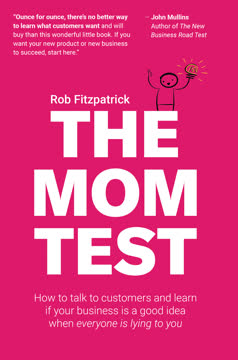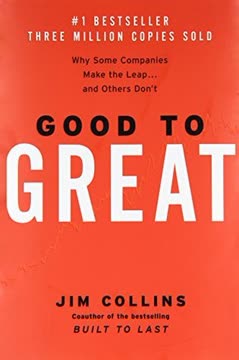Key Takeaways
1. Management innovation is the ultimate competitive advantage
Management innovation has a unique capacity to create a long-term advantage for your company.
Sustainable edge. Management innovation, which involves creating new ways of mobilizing talent, allocating resources, and building strategies, can provide a more durable competitive advantage than other forms of innovation. Unlike product or operational innovations, which can be easily copied, management innovations are deeply embedded in an organization's culture and practices, making them much harder for competitors to replicate.
Historical impact. Companies that have achieved long-term success, such as General Electric, DuPont, and Toyota, owe much of their enduring leadership to groundbreaking management innovations. These innovations have allowed them to consistently outperform competitors over decades, demonstrating the power of reinventing how work gets done.
Urgency for change. In today's rapidly evolving business landscape, traditional management approaches are increasingly inadequate. To thrive in the 21st century, companies must develop new management capabilities that foster adaptability, innovation, and engagement. Those who fail to innovate in management risk being left behind by more agile and forward-thinking competitors.
2. Challenge management orthodoxies to drive change
To escape the straitjacket of conventional thinking, you have to be able to distinguish between beliefs that describe the world as it is, and beliefs that describe the world as it is and must forever remain.
Question assumptions. To innovate in management, leaders must first identify and challenge deeply held beliefs about how organizations should operate. These orthodoxies often go unexamined and can become significant barriers to change and progress.
Systematic deconstruction. Use a structured approach to uncover shared beliefs within your organization:
- Assemble a diverse group of colleagues
- Have them write down their beliefs about a specific management issue
- Group similar beliefs together
- Focus on commonly held assumptions for scrutiny
Probe deeper. When examining management orthodoxies:
- Ask if the belief is worth challenging
- Look for counterexamples that challenge its universal validity
- Explore how the belief serves the interests of its adherents
- Consider whether choices and assumptions have made the belief self-fulfilling
3. Embrace new principles for 21st-century management
To build free societies based on self-rule, the 18th-century advocates of democracy had to renounce the time-honored principles of hereditary sovereignty.
New DNA for organizations. To create companies fit for the future, leaders must inject new principles into their management DNA. These principles should be drawn from systems that exhibit the cutting-edge qualities organizations need to develop, such as adaptability, innovation, and engagement.
Five key sources of inspiration:
- Life: Embrace variety and experimentation
- Markets: Foster flexibility in resource allocation
- Democracy: Enable activism and distributed leadership
- Faith: Cultivate meaning and purpose
- Cities: Increase opportunities for serendipity and creativity
Design rules for future-ready organizations:
- Favor experimentation over planning
- Create internal markets for ideas, talent, and resources
- Distribute decision-making power
- Align around a compelling mission
- Organize for serendipitous encounters and collaborations
4. Learn from positive deviants and fringe organizations
Anomalies defy logic. That's why they're usually ignored, or dismissed as irrelevant. If forced to make sense of W.L. Gore's weirdly effective organization, a myopic CEO would likely respond, "Yes, well, Gore is a privately held company"—as if that single fact allows Gore to defy all the usual laws of management.
Seek unconventional wisdom. To glimpse the future of management, look for "positive deviants" – organizations with practices that defy conventional norms yet deliver exceptional results. These outliers often hold valuable lessons for reinventing management.
Examples of fringe innovators:
- Grameen Bank: Pioneered microfinance without traditional collateral
- Linux: Developed a world-class operating system through open-source collaboration
- Craigslist and AdultFriendFinder: Created efficient online markets for various needs
Extract applicable insights. When studying these anomalies:
- Identify the specific problem they've solved in an unconventional way
- Analyze the methods, incentives, and infrastructure behind their approach
- Distill the underlying principles
- Consider how to translate their practices into your own organization
- Anticipate potential objections and develop counterarguments
5. Create a community of purpose to engage employees
Whole Foods. Whole People. Whole Planet.
Beyond profit. Whole Foods Market demonstrates how building a strong sense of community and shared purpose can drive exceptional employee engagement and business performance. Their approach goes beyond traditional hierarchical structures and profit-focused motivations.
Key elements of Whole Foods' community-driven model:
- Decentralized decision-making through empowered teams
- Transparency in compensation and financial information
- Profit-sharing and collective accountability
- Commitment to a higher purpose (health, sustainability)
- Culture of appreciation and interdependence
Benefits of this approach:
- Higher employee satisfaction and retention
- Increased productivity and innovation
- Strong customer loyalty
- Ability to attract top talent
- Sustained financial success
6. Build an innovation democracy to harness collective creativity
At Gore, the basic organizational unit is not the store, but the team. Small, empowered work groups are granted a degree of autonomy nearly unprecedented in retailing.
Unleash collective creativity. W.L. Gore & Associates has built a highly innovative organization by distributing power and fostering a culture of experimentation. Their approach demonstrates how to create an environment where innovation can come from anyone, anywhere in the company.
Gore's innovation-friendly practices:
- Flat, lattice-like structure with no formal hierarchy
- Leaders emerge based on their ability to attract followers
- Employees choose which projects to work on
- "Dabble time" for pursuing new ideas
- Peer-based selection and evaluation processes
Results of Gore's approach:
- Consistent track record of breakthrough innovations
- High employee satisfaction and engagement
- Ability to adapt quickly to market changes
- Sustained profitability and growth
7. Aim for evolutionary advantage through adaptability
Over time, every great invention, management included, travels a road that leads from birth to maturity, and occasionally to senescence.
Continuous renewal. Google's management model is designed to create a company that can evolve as rapidly as the internet itself. This focus on adaptability is crucial in today's fast-changing business environment.
Key components of Google's adaptive management system:
- 70-20-10 resource allocation rule for core, adjacent, and transformative initiatives
- Flat organizational structure with minimal hierarchy
- Emphasis on small, autonomous teams
- 20% time for employees to work on self-directed projects
- Data-driven decision making and rapid experimentation
Benefits of an evolutionary approach:
- Ability to identify and seize new opportunities quickly
- Resilience in the face of disruption
- Continuous innovation across the organization
- Attraction and retention of top talent
8. Develop a systematic approach to management innovation
While innovation can never be entirely scripted, it is possible to increase the odds of a "eureka" moment by assembling the right ingredients.
Structured creativity. To increase the likelihood of breakthrough management innovations, organizations need a disciplined approach that combines multiple elements:
-
Challenge orthodoxies:
- Systematically unearth and question long-standing management beliefs
- Distinguish between "what" and "how" in management practices
-
Embrace new principles:
- Draw inspiration from adaptable systems like life, markets, and cities
- Develop new management tenets aligned with 21st-century challenges
-
Learn from positive deviants:
- Study organizations with unconventional yet effective practices
- Extract applicable insights and principles
-
Encourage fresh thinking:
- Seek input from individuals without traditional management training
- Create diverse teams to tackle management challenges
9. Accelerate strategic renewal through new management processes
To get better at inventing new businesses, IBM was going to have to dramatically reinvent its management processes and values.
Systemic transformation. IBM's creation of the Emerging Business Opportunities (EBO) process demonstrates how new management approaches can drive strategic renewal and growth. By addressing deep-rooted impediments to innovation, IBM was able to significantly improve its ability to launch and scale new businesses.
Key elements of IBM's EBO process:
- Dedicated leadership and accountability for new growth initiatives
- Hybrid structure balancing corporate support and divisional expertise
- Top talent recruitment for new ventures
- Learning-focused metrics and milestones
- Protected funding and resources for emerging businesses
Outcomes of the EBO initiative:
- Launch of 25 new businesses in 5 years
- $15 billion in annual revenues from new ventures
- Shift in organizational culture towards valuing growth and innovation
10. Amplify human imagination by empowering all employees
We are the first generation in history that can honestly say, "We are limited only by our imagination."
Unleash creativity. In today's digital age, the tools for creativity are more accessible than ever. Organizations must tap into this potential by empowering all employees to become innovators, not just those in traditional creative roles.
Strategies for amplifying employee creativity:
- Provide access to innovation tools and resources
- Create platforms for sharing and developing ideas
- Implement opt-in systems for project participation
- Recognize and reward creative contributions
- Foster a culture that values experimentation and learning from failure
Benefits of democratizing innovation:
- Increased volume and diversity of ideas
- Higher employee engagement and satisfaction
- Faster problem-solving and adaptation
- Improved ability to attract and retain talent
11. Aggregate collective wisdom for better decision-making
Every day, companies bet millions of dollars on risky initiatives: new products, new ad campaigns, new factories, big mergers, and so on. History suggests that many of these projects will fail to deliver their expected returns.
Harness crowd intelligence. Best Buy's experiments with collective forecasting demonstrate the power of aggregating diverse perspectives for improved decision-making. By tapping into the distributed knowledge of employees, organizations can make more accurate predictions and better strategic choices.
Advantages of collective wisdom approaches:
- Access to a broader range of information and insights
- Reduction of individual biases and blind spots
- Increased engagement and buy-in from employees
- Ability to capture weak signals and emerging trends
Implementing collective intelligence systems:
- Create internal prediction markets or forecasting tournaments
- Develop platforms for anonymous idea sharing and voting
- Use crowdsourcing for problem-solving and innovation challenges
- Implement collaborative strategic planning processes
Last updated:
FAQ
What's The Future of Management about?
- Management Innovation Focus: The book emphasizes the need for management innovation to address the challenges of the 21st-century business environment.
- Reinventing Management Principles: It advocates for rethinking traditional management practices to create adaptable and engaging organizations.
- Case Studies: Real-world examples from companies like Whole Foods, W.L. Gore, and Google illustrate successful management innovations.
Why should I read The Future of Management?
- Timely Insights: The book provides relevant insights for leaders facing modern organizational challenges.
- Empowerment Vision: It offers a vision for creating workplaces that empower employees and foster creativity.
- Practical Frameworks: Readers gain access to methodologies for implementing management innovation.
What are the key takeaways of The Future of Management?
- Essential Management Innovation: Innovation in management is crucial for thriving amidst disruptive changes.
- Decentralization and Empowerment: Successful companies empower employees through decentralized decision-making.
- Continuous Learning: Organizations must adopt a mindset of continuous learning and adaptation.
What are the best quotes from The Future of Management and what do they mean?
- “Management is out of date.”: Highlights the need to evolve management practices to meet modern demands.
- “You’d rather lead than follow.”: Encourages proactive innovation in management practices.
- “The capacity to marshal resources...”: Stresses the importance of effective management in achieving organizational goals.
What is management innovation according to The Future of Management?
- Definition: Management innovation involves significant changes in management practices that enhance performance.
- Focus on Processes: It includes changes to processes, structures, and roles within organizations.
- Examples: The book provides examples of companies that have successfully implemented management innovations.
How does The Future of Management suggest organizations can empower employees?
- Decentralized Decision-Making: Advocates for giving frontline employees decision-making authority.
- Transparency and Trust: Emphasizes fostering a culture of transparency and trust.
- Peer-Based Accountability: Highlights the importance of peer accountability over top-down management.
What challenges does The Future of Management identify for modern organizations?
- Rapid Change: Organizations face challenges due to fast-paced change and technological disruptions.
- Inflexible Models: Traditional management models are often too rigid to adapt effectively.
- Cultural Resistance: There is often resistance to adopting new management practices.
How does The Future of Management propose to overcome management myopia?
- Challenging Assumptions: Encourages questioning long-held management beliefs.
- Engaging Diverse Perspectives: Involves a broader range of voices in decision-making.
- Culture of Experimentation: Advocates for a culture that encourages experimentation and learning from failure.
What role do case studies play in The Future of Management?
- Real-World Examples: Case studies illustrate how innovative management practices lead to success.
- Lessons Learned: Provide insights into specific management innovations and their outcomes.
- Inspiration for Change: Serve as inspiration for challenging conventional practices.
How can organizations implement the ideas from The Future of Management?
- Start with a Vision: Leaders should articulate a clear vision for management innovation.
- Engage Employees: Involve employees in discussions about management practices.
- Experiment and Iterate: Adopt a mindset of experimentation to refine management approaches.
What is the EBO process mentioned in The Future of Management?
- Emerging Business Opportunities: A structured approach developed by IBM for new business initiatives.
- Accountability and Leadership: Assigns senior executives to oversee new ventures.
- Focus on Learning: Emphasizes learning and experimentation over immediate profitability.
How does The Future of Management define the relationship between discipline and freedom in organizations?
- Coexistence: Organizations can maintain discipline while allowing employee freedom.
- Examples: Companies like Whole Foods and Gore demonstrate this balance.
- Four Conditions: Accountability, access to data, decision authority, and recognition link results to success.
Review Summary
The Future of Management receives mostly positive reviews for its innovative ideas on reinventing management practices. Readers appreciate Hamel's insights on empowering employees, fostering creativity, and adapting to rapid change. The book's case studies of successful companies like Whole Foods, W.L. Gore, and Google are frequently cited as valuable examples. Some reviewers find the content repetitive or outdated, but many consider it a thought-provoking read for leaders seeking to transform their organizations and prepare for future challenges in the business world.
Similar Books






Download PDF
Download EPUB
.epub digital book format is ideal for reading ebooks on phones, tablets, and e-readers.






